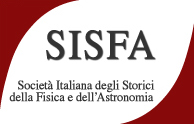Conveners
Planetary theories and astronomical instruments: mechanizations and visualizations between geocentrism and heliocentrism (1400-1700): Part 1
- GIOVANNI CARLOTTI (University of Perugia - Dept of Physcis and Geology)
Planetary theories and astronomical instruments: mechanizations and visualizations between geocentrism and heliocentrism (1400-1700): Part 2
- Flavia Marcacci (Pontifical Lateran University)
Planetary theories and astronomical instruments: mechanizations and visualizations between geocentrism and heliocentrism (1400-1700): Part 3
- Giancarlo Truffa (Member of SISFA)
Planetary theories and astronomical instruments: mechanizations and visualizations between geocentrism and heliocentrism (1400-1700): Part 4
- Fabrizio Bonoli (Università di Bologna)
Between the XV e il XVI century, three generations of architects, engineers, and manufacturers of machines, clocks, astronomical and measuring instruments stood out in the Della Volpaia family. The Salviati, Rucellai, the Medici, and other Florentine noble families estimated their works. Many members of the Della Volpaia family were in relationships with numerous established artists, such as...
Girolamo Della Volpaia (1530-1614), member of one of the most important families of instrument and clock makers based in Florence during the Renaissance, made many instruments now disseminated in public and private collections around the world. There are sundials of different kinds, nocturlabes, horary quadrants and armillary spheres, all made with great skill, both technical and artistic.
He...
Mercury and Venus are the closest planets to the Sun and the Earth. In the geocentric model, they were situated near the Earth: above the Moon and below the Sun; for this reason, they were called “inferior” planets according to the Ptolemaic system. Following the Platonic system, those planets were located above the Moon and the Sun and below Mars. In the so-called “Egyptian” system, derived...
Antonio Santucci of Pomarance (d. 1613), cosmographer of the Grand Duke of Tuscany Ferdinando I de 'Medici, went down in history for a New Treatise on Comets published in 1611 and reprinted posthumously in 1619. Another of his treatises "Above the New Invention of the Armillary Sphere” has instead remained in manuscript form. The making of the object described therein is believed to coincide...
Why talk about Egnatio Danti in Perugia? Danti was an exemplary protagonist of the Renaissance homo faber and also author of important treatises on mathematics and optics. Carlo Pellegrino was born in Perugia in 1536 and changed his name to Egnatio when he entered the Dominican Order to take up the priesthood. As a boy with his aunt Teodora, he studied Mathematics, Geometry and Astronomy....
In this talk I'll sketch the outlines of a new interpretation of the Antikythera Mechanism (II cent. BC). My aim is twofold: 1. To reassess the role of sphairopoiia (i.e. construction of spheres) in the development, reception, and transmission of Greek mathematical astronomy. 2. To reconstruct the astronomical theory embedded in the Antikythera Mechanism, following the constraints imposed...
Federico Commandino’s Latin editions of the mathematical works of the ancient Greeks constituted an essential point of reference for the scientific research of the moderns. Thanks to his tireless work of understanding and reestablishing the texts of Euclid, Archimedes, Ptolemy, Apollonius and Pappo, the mathematics of the moderns was able to lift its sails to overcome the Hercules columns of...

